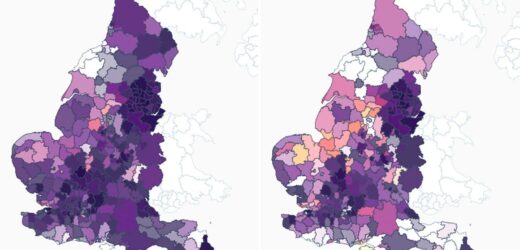THESE shocking maps reveal where the Delta variant has spread in just one week.
The new strain delayed England's Freedom Day – which would have been today.
🔵 Read our coronavirus live blog for the latest updates
It spread throughout the country, with hotspots in the north taking the initial brunt.
But now the variant has taken over as the dominant strain, and makes up 99 per cent of all cases.
Maps from the Wellcome Sanger Institute show the dramatic change in the picture over the past few weeks.
The most recent data – up to June 12 – shows very few spots have below 50 per cent of cases as Delta.
The data is a few days out of date because it takes at least a week for scientists to analyse Covid swab tests.
The maps shows Bolton, an original Delta hotspot, saw 483 cases per week in the two weeks up to June 12. But this is less than the week previous as distancing measures start to work.
And Cornwall, which was seeing very low cases at the beginning of the month, saw a large spike in the run up to June 12, when about 112 Delta cases were reported.
In London most boroughs are seeing over 90 per cent of cases as Delta.
As of June 12, Croydon had about 61 cases a week, Westminster had about 45 each week, Southwark had about 114 every seven days and Tower Hamlets was seeing around 124 each week.
'RISING RAPIDLY'
Last week we told how in less than a month the strain has become dominant in almost every authority in England, making up at least half of the infections there.
Public Health England (PHE) reported the total number of Delta cases detected has gone up from 42,323 last week to 75,953 today – an increase of 33,630.
It’s also a five-fold increase from two weeks ago, when the figure was 12,341.
Dr Jenny Harries, Chief Executive of the UK Health Security Agency, said: “Cases are rising rapidly across the country and the Delta variant is now dominant.
“The increase is primarily in younger age groups, a large proportion of which were unvaccinated but are now being invited to receive the vaccine."
Government data shows that Covid cases are highest in people in their 20s, followed by those aged between 10 and 19.
Dr Harries said: "It is encouraging to see that hospitalisations and deaths are not rising at the same rate but we will continue to monitor it closely.
"The vaccination programme and the care that we are all taking to follow the guidance are continuing to save lives.
“Please make sure that you come forward to receive both doses of the vaccine as soon as you are eligible. Don’t drop your guard- practice 'hands, face, space, fresh air' at all times.”
However if an area has a high proportion of Delta cases, it does not necessarily mean there are lots of cases there.
For example, Delta is 100 per cent dominant in East Hertfordshire, but only 34 cases are diagnosed there per week, which is low.
Delta is at least 60 per cent more transmissible, and its ability to dodge some immunity from vaccines gives it an advantage to keep spreading.
Warnings of a “substantial third wave” in light of Delta have forced the Government to reconsider lifting lockdown on June 21.
It comes even though other aspects of the outbreak have significantly improved, with barely any increase in the nationwide hospital admissions.
A delay of four weeks or more is hoped to give more time to give around 10 million vaccine doses to boost the nation’s protection.
Source: Read Full Article





